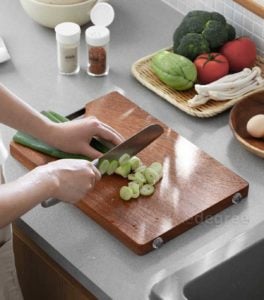Not sure which cutting board might be the right one for you? We’ve consolidated pros and cons of wooden, plastic, stainless steel and silicone cutting boards to help you with that. Get natural ways to get rid of stains on your cutting board too!
1. Wooden Cutting Boards

Ft. Oishii Wooden Chopping Board
Wooden cutting boards are a classic as they are durable, attractive, and also a more eco-friendly option! Some types of wooden cutting boards, like maple and beech, are also known to self-heal knife scratches.
Pros of Wooden Chopping Board
- Sturdy for chopping food
- Durable with the right care
- Does not damage knives
- Some wooden boards self-heal and repair their scratches automatically
Cons of Wooden Chopping Board
- Does not tolerate excessive moisture, wipe it dry with a cloth and sundry it.
- Absorbs odours and collects stains
- Due to its organic material, it needs to be cared for properly. To prevent drying out, warping and cracking, wipe your wooden cutting board down with mineral oil, coconut oil or beeswax every month.
Also check out on StyleMag: 8 Queries On Cleaning Wooden Utensils & Chopping Board, All Answered!
How To Remove Stains On Wooden Cutting Boards
All you need are baking soda and lemon. Baking soda is a natural bleaching agent commonly used for removing stains. Combine it with an antibacterial lemon, and your cutting board will be as good as new!
Steps:
- Sprinkle enough baking soda to cover the stains
- Squeeze lemon juice over it and use the fruit to scrub the stain off.
- Rinse off residue and wipe down with a cloth.
2. Plastic Cutting Boards
![]()
Ft. Trio Multi Chopping Board (With Holder)
Plastic cutting boards are inexpensive and very easy to replace because of that. Coming in different colours, you can buy multiple to colour-code and use them for cutting different types of food!
Pros of Plastic Chopping Board
- Common and easy to find
- Less expensive
- Comes in many different colours, and can be colour-coded for different types of food to prevent cross-contamination.
Cons of Plastic Chopping Board
- Bacteria grows in deep knife marks, so it might be harder to clean. Replace it when the surface feels rough and shaggy.
- Can warp in the dishwasher, hand-wash and air dry it instead
- Stains quite easily
How To Remove Stains On Plastic Cutting Boards
For plastic cutting boards, you’ll need around 1 tablespoon of the following: vinegar, baking soda, salt, and half of a lemon. Just like baking soda, white vinegar works wonders in removing stains in many objects like clothes, rugs and even cutting boards!
Steps:
- Sprinkle enough baking soda, vinegar and salt to cover the stains.
- Using half a lemon, scrub off the stains.
- Rinse off residue.
3. Stainless Steel Cutting Boards
![]()
Ft. Modern Double-Sided Cutting Board
A more modern approach to cutting boards, stainless steel cutting boards are less common but are one of the most hygienic in this list! They are usually used in the kitchen for chopping meat. With its non-porous surface, they won’t absorb unwanted juices or residue, so they’ll be free from stains and odour!
Pros of Stainless Steel Cutting Board
- Hygienic, very easy to keep clean
- Dishwasher safe, not susceptible to warping unlike plastic
- Does not absorb unwanted juices
Cons of Stainless Steel Cutting Board
- Dulls blade overtime easily, so it’s best to keep a knife sharpener at hand if you’ll be using a stainless steel cutting board.
- May be more slippery for knives
4. Silicone Cutting Boards
Another less type of cutting board you don’t often see, silicone cutting boards have a unique advantage of flexibility. You can bend it to transfer food to another plate without creating a mess!
Pros of Silicone Cutting Board
- Knives won’t damage easily due to softness
- Flexible, bend and transfer food mess-free
- Non-porous surface, bacteria resistant
- Dishwasher-friendly
- Easy to wash
- Affordable
Cons of Silicone Cutting Board
- Easily damaged from knife marks. Just like plastic cutting boards, replace when it’s too rough for use.
- Retains food smells
- Prone to stains
How To Remove Stains On Silicone Cutting Boards
For silicone cutting boards, all you need are baking soda and hot water.
Steps:
- Sprinkle enough baking soda to cover the stains on the cutting board.
- Pour hot water onto the baking soda until it forms a paste, and let it dry.
- Rinse off mixture and wash silicone cutting board with dish soap as per normal.
Here are other tips to help you choose the right cutting board:
- Get cutting boards with anti-slip paddings so that they don’t slide around as you chop.
- Have different sized cutting boards for different jobs: small ones for quickly slicing fruit and bigger ones for chopping big chunks of meat.
- Besides having colour-coded boards, getting a double-sided cutting board is also an option if you want to save space!
- Hanging loops in cutting boards are not only useful for hanging them to dry, but you can swipe food into them to prevent a messy counter. Click here to see how you can do so!
Let us know which cutting board you find the most useful!



